Why Are OKCPS Teachers Begging the Public for Basics?
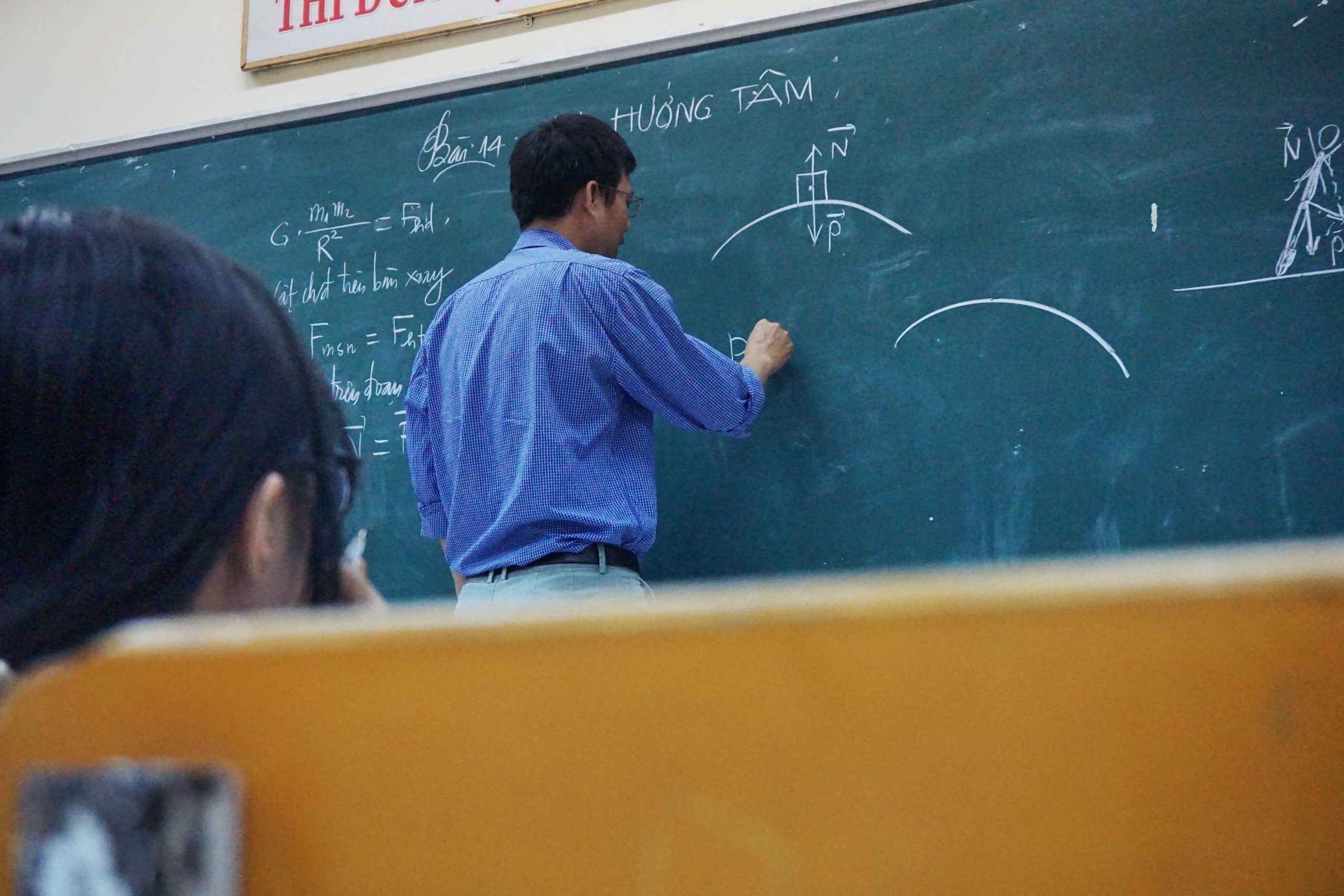
Authors
Byron Schlomach (with research assistance by Benjamin Lepak and Mike Davis)
Abstract
This paper describes how 1889 Institute staff found $34,000 in DonorsChoose solicitations by Oklahoma City Public Schools teachers for classroom necessities. These include appropriately sized chairs for an elementary library to fit existing tables, a bulb for a district-provided PowerPoint projector, and printers to take the place of broken and under-provisioned school copiers and printers. We describe why this is not a funding problem, but a prioritization problem.
Full Text HTML
Why Are OKCPS Teachers Begging the Public for Basics?
Byron Schlomach
with research assistance from Ben Lepak and Mike Davis
Public school teachers persistently complain of not having the material support they need in their classrooms.[1] They spend their own money not only to provide basic school supplies for which parents should be responsible, such as pens, pencils, and paper, they also spend their own money and go begging for basics that should be readily available from their employers – school districts.
Professional service workers in offices typically have necessities required to get their jobs done provided to them by their employers. Items such as office equipment, paper for copiers, printers, printer ink, pens, writing paper, desks, tables, and chairs are automatically provided by employers since, after all, these are generic items that are absolutely necessary to get the job done in virtually any office. Teachers in the Oklahoma City Public Schools (OKCPS), however, evidently cannot necessarily count on basic resources being provided to them. The evidence is on the internet, as explained below.
The lack of resources in teacher classrooms, however, cannot be attributed to “underfunding,” also explained below. This is a nebulous term that has no meaning. If it had true meaning, those who cast it about so freely would be able to provide numbers that represent “full funding,” something they manage never to do. This might be because they do not know, but more likely it’s because we already fund more than what they would have considered adequate 20 years ago.
The lack of necessary classroom resources in OKCPS is attributable to a misallocation of resources. We need only show that the total amount of resources available for OKCPS to spend is adequate to more than fund classroom basics. How resources are misallocated and spent in wasteful ways would best be determined by a thorough management audit. In lieu of that, we turn to evidence provided by OKCPS teachers on the website, DonorsChoose.org.
DonorsChoose.org
The DonorsChoose.org website allows individual teachers to solicit donations for specific items. A teacher explains the circumstances of his/her school, its demographics, and behavioral as well as material challenges. Then, the teacher explains issues specific to the individual classroom. The teacher specifies material needs or wants that would make the classroom experience better for the teacher, the students, or both. These material needs are itemized, along with their associated costs, state sales tax, and a fee to Donors Choose. Individuals, foundations, and other entities can then donate, either in part or in whole, to a specific teacher’s classroom.
Teachers’ requests on Donors Choose run the gamut. Some request money to buy bulletin board decorating supplies. Others ask for trinkets to hand out as rewards to students. Playground equipment might be requested. Apparently, the current fad in kindergarten and other early grades is to have “flexible seating” such as bean bags, balls, and thick rugs, for students to use instead of desks. Some teachers ask for computer gaming equipment. Another common early-grade request is for shelves and rugs to create a “cozy corner” for reading.
Clearly, many of the material requests are not necessities, at least not in the minds of many, and not by the standards of this analysis. A cozy corner might be nice, computer games might be fun, and pretty bulletin boards might be eye-catching, but none of these are necessities to a classroom (though a classroom without them would be boring). A surprising number of requests on the part of teachers in Oklahoma City’s schools, however, are obvious necessities such as basic furniture, frogs to dissect, bulbs for a classroom projector, printers due to poorly maintained district-provided machines, textbooks, math manipulatives, and more as explained below.
Before breaking down OKCPS teachers’ needs requests, it is worth considering why teachers are suffering privation in their classrooms. Obviously, these teachers work in an urban school district where many of the campuses could be considered inner-city. Perhaps the problem is inadequate funding. After all, the last decade has seen an actual reduction in inflation-adjusted per-student spending in Oklahoma, an unprecedented event over the last one-hundred years (see graph below). A familiar narrative across the country laments funding for inner-city public schools. And, it is very common for those who administer these schools to claim poverty in the face of their “unique” needs. In fact, the teachers who solicit funds on Donors Choose cite all these issues, repeating what they have been told by their administrators. It is, after all, a message that sells.
Figure 1: Oklahoma’s Inflation-adjusted Per-student Spending
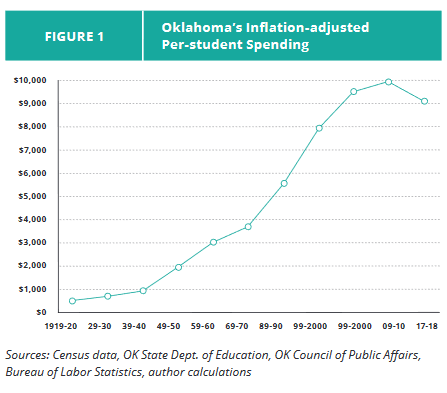
In order to consider the question of whether OKCPS’s schools suffer from a lack of resources, we must turn to the data tool of the Oklahoma Council of Public Affairs (OCPA). Normally, state sources would be consulted, but the Oklahoma Legislature, at the behest of the state’s school board association and other public school interests, has seen fit to mandate that the State Department of Education hide total spending from the people of Oklahoma.
According to state data obtained through open records requests and posted by OCPA, OKCPS spent an average of $12,080 per student in 2018, as compared to $10,793 per student in the state as a whole. In this all-encompassing measure of spending, Oklahoma City spent almost $1,300 per student more than was spent per student in the state as a whole. That is, Oklahoma City’s school district spent 12 percent more than the statewide average, on a per-student basis. Clearly, Oklahoma City is definitely not impoverished, at least not compared to other districts around the state.
One problem with the totals just mentioned is that they include spending from revenues like the sale of sports tickets. A small amount of spending is redundantly recorded due to accounting corrections in the aforementioned measure as well. And, there are always protests from public school administrators that spending on school buildings should not be included since not every district is in a construction mode and bond payments can represent double-counting while buildings are being constructed and those expenses are included. So, for the sake of making comparisons across school districts, only expenditures under the “Instruction” and “Support Services” function categories are included. The districts in Table 1 represent a cross-section of sizes, from 4,000 students (Piedmont) to 38,000 students (OKC). The two Epic schools are included partly due to their being in the news due to an investigation to find out if they ended up with more money than they were supposed to.
Table 1: Instruction and Support Service Per-student Expenditures: Statewide & Selected Districts
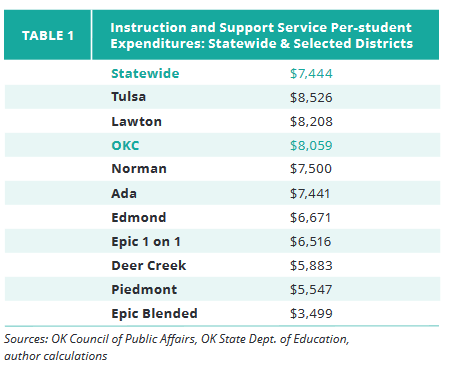
Sources: OK Council of Public Affairs, OK State Dept. of Education, author calculations
These numbers do not suggest in any way that Oklahoma City Public Schools are impoverished, certainly not in comparison to other districts in the state. Two of the districts included in the table, Tulsa and Lawton, spend more than OKCPS, but OKCPS is closer in spending to them than to the statewide average.
At $8,059 per student, a class of 30 children represents $241,770 in spending. Even if we allow a generous $100,000 for teachers of these children, that still leaves $141,000. One brand new $150 book for each child (books for all subjects are rarely all replaced at once) amounts to $45,000. Electricity for lighting and air conditioning should not amount to more than $4,500 during a school year. Another $10,000 for administrative services still leaves $82,500 for paper, copiers, cleaning, maintenance, and other services. Oklahoma City’s public schools are anything but impoverished. This is especially true in comparison to the Piedmont district, where per-student spending is at only 70 percent of what OKCPS spends on Instruction and Support Services. These figures, by the way, pre-date significant state funding increases in effect for the 2019-20 school year.
1889’s Analysis
On August 22, 2019, the beginning of the 2019-20 school year, 1889 Institute analysts scrolled through the entire list of Donors Choose grant requests from Oklahoma City’s school teachers. The effort was to identify grant requests for obvious necessities. That is, the effort was to identify true needs of teachers and their classrooms that had gone unfulfilled by the district’s school administrations. Anything not considered a basic necessity was ruled out. Thus, many requests for computers and other electronic devices are not included in the list of necessities identified by 1889 Institute. Several requests for computers are included when the need identified has something to do with preparing students for computer-based accountability tests. Requests for supplies that are generally considered parent responsibilities are not included as well. Flexible seating and cozy corners were not considered necessities.
It should be noted that three different analysts looked through the list of requests, each reviewing a separate part. Although there was an effort at consistency, complete consistency in accounting for the expenses was not fully achieved. Some grant request totals include items that would not likely be judged necessities while other grant totals are smaller than the original grant’s total since the analyst excluded some items not considered necessities. There are cases where totals include state sales tax as well as a commission to Donors Choose. Mostly, the totals reflect before-tax and before-commission amounts. The goal was not to get the final dollar totals accurate to the penny. And, it is likely some of the items could be purchased cheaper than through the channels provided to teachers by Donors Choose. The goal is to point out that true needs of teachers and classrooms are not being fulfilled by the administration of OKCPS despite the fact that the district has adequate resources to do so.
In the tables below, specific grant requests are listed with very basic descriptions of what would be funded with the donations. The amounts of requests and the campuses from which these requests are made are included as well. The teachers’ names have been redacted.
Printers/Print Supplies
A basic for teachers to accomplish their jobs is access to reliable document duplication equipment, well-supplied with paper and ink. Teachers need the ability to duplicate homework assignments, tests, and supplemental curricula to hand out to students. If this equipment is underprovided and/or unreliable, teachers’ time is wasted standing in line or from repeatedly making attempts to make copies. Teachers might be forced to change their teaching and testing strategies. Time is wasted in class having students duplicate instructions on a board, or copying a PowerPoint slide. Student errors then become an issue, with more wasted time if a student does a homework assignment improperly due to the student’s error in copying down an assignment.
Despite how critical paper is to current educational practice, the sad fact is that teachers have been forced to write Donors Choose requests for something as basic as copy paper.[2] A sixth-grade teacher in Oklahoma City, at the beginning of the 2019-20 school year, has resorted to requiring students to take phone photos of homework assignments for lack of access to reliable duplicating facilities.[3] This has created problems for students without smartphones.
As seen in the table below, eight different teachers posted requests totaling over $3,600 for help to purchase printers and/or printer supplies for their classrooms, mostly due to the constant disrepair of school-based duplicating facilities. Two requests were for printing supplies for classes already supplied with printers, including a request for something as basic as paper.
Perhaps its administrators consider Oklahoma City Public Schools an exception to the basic logistical need for paper in the educational process. Or, perhaps this is a strategy to create the impression that the district is too poor to provide anything so basic as paper and decent duplicating machines. Or, perhaps it is just one example of gross incompetence on the part of those in charge of providing educational practitioners (teachers) the basics of what they need to accomplish their jobs. Another explanation might be that other support personnel in charge of technology upkeep simply are not doing their jobs and their ultimate supervisors are miserably failing to hold them accountable.
Table 2: Printer/Printer Supply Requests

Basic Instructional Supplies
What former public school student of the last 30 years or so does not remember “playing” with math manipulatives as part of learning about addition and subtraction? Perhaps for many, it is not an absolute necessity to have access to such a tool, but math manipulatives have been a basic part of the early math-learning process now for well over half a century.[4] Weekly Reader as part of the early childhood reading experience has been around just as long, and has been a basic in all that time. So are dictionaries, a periodic table to post on a wall, frogs for dissection in a biology class, and nonfiction books in a library.
All these are basics historically provided by public schools without teachers having to dip into their own finances or go begging for additional community support in addition to what taxpayers are already providing. Nevertheless, OKCPS public school teachers have requested almost $9,000 from outside sources in order to purchase some of the most basic supplies to outfit a classroom for a particular subject. One wonders if such supplies are regularly destroyed, thrown away, or stolen at OKCPS. Or, perhaps OKCPS priorities are grossly misplaced.
Table 3: Basic Traditional Classroom Supplies
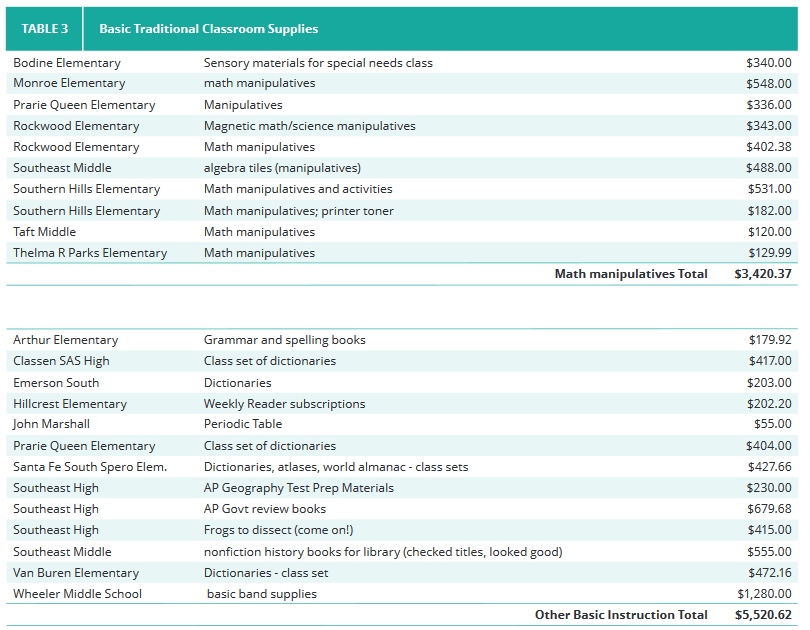
Furniture
We know we are spoiling today’s students in our public schools when they have a proper place to sit, a locker or cubby to place personal property like coats, tables for projects, and their teachers have boards and filing cabinets. Of course, this statement is absurd, but apparently not to those who control the resources of OKCPS, as demonstrated by Table 4 below. OKCPS teachers have requested donations for over $10,000 in basic functional furnishings. These include a considerable expense for chairs appropriate for small children and that actually fit the tables available to them. Admittedly, a single request represents almost $3,000 of this total, but it is a bit of a mystery how anyone playing a bass saxophone or a bassoon would do so while sitting on a bench. Band has been a basic from junior high on in public schools for many decades.
Table 4: Basic Furniture
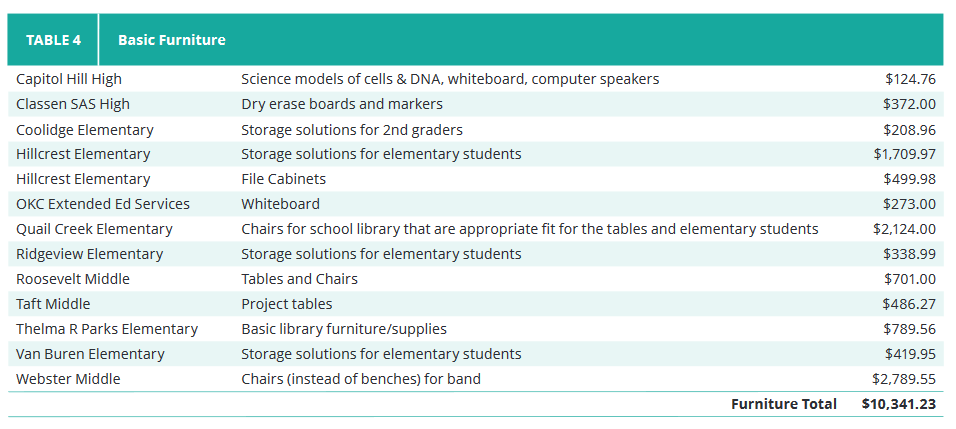
Computers
Most of the computer requests listed below, amounting to over $6,500, come from elementary school classroom teachers. Many more donation requests for computers existed at the time of 1889’s review than are listed in Table 5. However, to be considered a necessity, especially for elementary students, the computers requested had to be for absolutely essential purposes. None of the computer requests listed here are to outfit an entire classroom with computers to make a “one-to-one” classroom (a computer for every child – no sharing). They are for test preparation, where such testing occurs on computers, and in most cases a single computer would be shared among at least five children.
Table 5: Computers

Tech Support/Upkeep
One wonders if those who purchase power point projectors think bulbs never burn out, or if remotes to control the projectors are not subject to breakage, theft, and loss. And, as ubiquitous as the old overhead projectors once were, perhaps public school administrators are not clear, despite the large number of projectors already purchased, that technology is now an integral part of the classroom. Regardless, when it comes to technology, half measures seem to be the rule rather than the exception, all the better, perhaps, for furthering claims of “under-funding.” As noted in an earlier 1889 Institute publication, teachers often lack the proper software to interface with expensive smart boards, making the equipment nothing more than very expensive projector screens.[5] Thus, teachers in OKCPS requested $600 in donations for basics to make district-provided technology functional.
Table 6: Tech Support/Upkeep

Hygiene/Safety Supplies
One would think that safety and hygiene would figure as basic necessities. But no, teachers find themselves responsible to collect over $1,600 in donations to provide hygiene and safety necessities.
Table 7: Hygiene/Safety Supplies

Physical Education
Equipment for sports, for the most part, was not considered a necessity for purposes of this study. However, where teachers request the most basic of physical education equipment, such as simple balls and racks to store them, then they were considered necessities. Although teachers and some experts have said so for years, there is now an increasing realization that physical activity and recess are important for learning, granting energetic children breaks from sitting and allowing them to burn off pent-up energy.[6] Thus, some requests, totaling more than $2,300, for recess and sports equipment were deemed necessary by 1889’s analysts.
Table 8: PE/Recess Equipment

Conclusion
In total, 1889 analysts identified around $34,000-worth of donation requests by OKCPS teachers for the purchase of what are arguably necessities that should be readily provided by the district. Many teachers would probably argue that this study grossly understates the needs. There is no way to know how much teachers have spent out of their own pockets for printers, paper, ink, bookcases, staplers, whiteboard supplies, and any number of other items that should be the district’s responsibility.
A legitimate question might be about what teachers from other districts are requesting. The answer is that it would take much more than available resources to completely survey Donors Choose requests from every Oklahoma school district on a single day at the beginning of a school year. However, it is notable that only three requests were listed from the much lower-spending Piedmont district, all from the same teacher, none of which would be considered necessities.
As has been noted elsewhere, for all the talk about how much those in charge of public education care about students, learning, and teachers, their actions speak louder than words. When teachers have to go begging for basic equipment and supplies to make modern classrooms work in what is actually a well-funded district, it is obvious that politics and administrative convenience are higher priorities to those in charge than managerial excellence, accountability, and the educational process.
_________________________
- Niraj Chokshi, “94 Percent of U.S. Teachers Spend Their Own Money on School Supplies, Survey Finds,” New York Times, May 16, 2018, https://www.nytimes.com/2018/05/16/us/teachers-school-supplies.html. ↑
- The author’s wife used Donors Choose to obtain copy paper during the 2018-19 school year at an OKCPS school that historically relied on paper donations from a student’s parent. ↑
- Based on remarks from a parents’ group Facebook page complaining about the blurry pictures. ↑
- Judging by the author’s first-grade matriculation experience, which began 51 years ago. ↑
- Byron Schlomach, Straight Talk on Public Education, 1889 Institute Policy Analysis, July 2018, https://img1.wsimg.com/blobby/go/8a89c4f1-3714-49e5-866b-3f6930172647/downloads/1d0kn3iaa_522966.pdf. ↑
- Abel J. Koury, “Why We Need Recess Now More than Ever,” Crane Center for Early Childhood Research and Policy, OSU.edu, https://earlychildhood.ehe.osu.edu/research/why-we-need-recess-now-more-than-ever/. ↑
